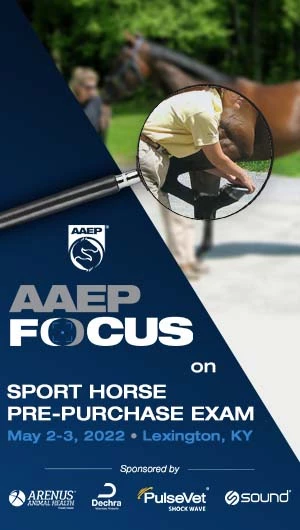AAEP Focus on Sport Horse Pre-Purchase Exam

When
May 02, 2022
to May 03, 2022
Where
Spy Coast Farm Equine Education Center
Lexington, Kentucky
Online Presentations: starting April 7, open indefinitely
In-person Labs: May 2 & 3
CE Hours: 21.5 Total (11 CEUs for the recorded online lectures; 10.5 for the demo, labs on-site)
CE credits available until May 3, 2023
----
From the ABCs of a successful examination to effectively communicating your findings to both the client and the other parties involved, Focus on Sport Horse Pre-Purchase Exam sets you up for success when performing this important service.
Focus Format:
The event will use a “flipped classroom” model in which attendees complete relevant instructional material at home prior to the event, so that in-person time is devoted to experiential learning through skills application and analysis.
Beginning April 7, registrants will be provided digital resources through an online Learning Management System in the form of instructional videos on the subject matter of the wet labs. Registrants will complete pre-meeting quizzes to ensure understanding and to qualify for CE credits.
Hands-on Wet Labs:
Each registrant will participate in six labs May 2 – 3 in Lexington:
Radiographs of the Spine – Dr. Kent Allen
Radiographs of the Limb – Dr. Kent Allen
Dynamic Evaluation: Application and Evaluation of Dynamic Gait Analysis – Dr. Mark Baus and Dr. Laurie Tyrell
Learn how to employ the most commonly used system of dynamic gait analysis, the Equinosis Q or Lameness Locator, in a pre-purchase exam.
Neurology – Dr. Steve Reed
Ultrasound – Dr. Ryland Edwards
Objective Lameness Measurement – Dr. Mark Baus
Learn how to incorporate inertial sensors into your pre-purchase exam in a way that is seamless with your existing routine.
Virtual (online) presentations:
- Communicating with the Purchaser Before and After the Pre-Purchase Exam – Mark Baus
Grasp the importance of determining a buyer’s exact expectations for their new horse and from the exam, and then communicating findings to help the buyer make a purchase decision. - Purchase Examinations of the Sport Horse: “Head to Tail” – Rick Mitchell
Learn how to perform a carefully orchestrated, well executed, and repeatable sport horse purchase exam. The exam and reporting process should consider the business transaction between the veterinarian and buyer, the expectations of the buyer, and the physical characteristics of the horse, with special consideration given to certain physical findings based on its intended use. - Laboratory Tests and Ancillary Diagnostics for the Purchase Examination – Rick Mitchell
Explore the variety of laboratory tests as well as imaging techniques such as endoscopy, radiography and ultrasonography that may be part of the purchase exam. More advanced imaging such as thermography, scintigraphy and MRI may be appropriate in some cases. The appropriate tests and imaging depend on the information gathered during the physical exam and the horse’s intended discipline.
- Pre-Purchases in Review: Reflection of Historical Data Pertaining to Pre-Purchase Exams – Kent Allen
Examine the available literature on the pre-purchase exam around the world and look at a non-published survey of 700 pre-purchase exams in a single practice that shows outcomes and summarizes why some horses were considered unsuitable. - Getting to the Heart of the Matter: When Specialized Testing is Recommended in a Pre-Purchase Exam – Mary Durando
Discover the features of a thorough physical exam (resting and exercising), pertinent historical questions to evaluate the cardio-pulmonary system, and portions of the exam that should be tailored to the horse’s intended purpose. Findings that are unlikely to be a problem, as well as those that warrant more in-depth, specialized tests will be discussed, with particular emphasis on the echocardiogram and electrocardiogram (resting and exercising). Common potential results and the likely impact on athletic potential will be mentioned. - Star Pupil: Perfecting the Ophthalmic Portion of a Pre-Purchase Exam – Stephanie Bell
Explore a systematic approach to the ophthalmic exam focused on identifying abnormalities and anomalies and distinguishing these from variations of normal. Potential clinical significance of ophthalmic findings will be discussed.
- Neurologic or Lameness? – Steve Reed
Use case studies to differentiate between lameness and neurologic conditions, with additional discussion on repeatability of both the lameness and neurologic exams and how these can be made more consistent. - Radiography: Proper Positioning and Normal Abnormalities – Kurt Selberg
Achieve optimum radiographs through proper positioning and equipment; and review radiographic abnormalities that have little effect on the horse’s future capability. - Radiography of the Spine – Kurt Selberg
Attain suitable images of the back, an increasingly significant component of pre-purchase exams, with large machines and field portable units. - Alternative Imaging Techniques for Evaluation of the Purchase Examination – Rick Mitchell
Clarify issues that are difficult to interpret and provide the client with practical advice by using multiple imaging modalities. Radiography has been the gold standard, but ultrasound, thermography, nuclear scintigraphy, MRI and even CT may enhance the veterinarian’s ability to dispense good advice to the client. Some newer technology may even provide predictive capabilities. - Effective Dialogue Between Colleagues: Communicating Findings to Other Veterinarians – Kent Allen
Learn how to communicate effectively amongst clients and their veterinarians (both buyer and seller) without becoming embroiled in controversy and litigation.
- Applications of Objective Lameness Measurement in the Pre-Purchase Exam – Mark Baus
Discover the best way to integrate inertial sensors into the pre-purchase exam to produce useful information and protect yourself in the process. - Evaluation of the OTTB for Their Second Career – Jeff Berk & Anna Ford
Explore a veterinary approach to the examination and evaluation of the suitability of retired Thoroughbred racehorses for second career options. Case studies will illustrate the process and outcomes. - Exploring Legal Pitfalls of the Pre-Purchase Exam – Mike Casey, Mike Meuser, Jeff Berk, & Kit Miller
Acquire an overview of the legal considerations relative to pre-purchase exams, followed by case studies and outcomes.